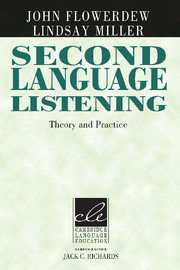Book contents
- Frontmatter
- Contents
- Series editor's preface
- Preface
- Acknowledgments
- Part I HISTORICAL BACKGROUND
- 1 Approaches to Language Teaching and the Role of Listening
- 2 Models of Listening
- 3 Types of Meaning for Listening
- 4 The Nature of Spoken Language
- 5 Learning Styles and Listening Strategies
- Part II A PEDAGOGICAL MODEL AND ITS APPLICATION
- Part III KEY ISSUES IN TEACHING AND TESTING
- Appendix: Concluding Questions for Reflection
- References
- Index
2 - Models of Listening
Published online by Cambridge University Press: 04 February 2010
- Frontmatter
- Contents
- Series editor's preface
- Preface
- Acknowledgments
- Part I HISTORICAL BACKGROUND
- 1 Approaches to Language Teaching and the Role of Listening
- 2 Models of Listening
- 3 Types of Meaning for Listening
- 4 The Nature of Spoken Language
- 5 Learning Styles and Listening Strategies
- Part II A PEDAGOGICAL MODEL AND ITS APPLICATION
- Part III KEY ISSUES IN TEACHING AND TESTING
- Appendix: Concluding Questions for Reflection
- References
- Index
Summary
Introduction
In this chapter, we consider some of the basics in learning to listen. The ability to hear is a natural process that develops in all normal infants. Indeed, most of us begin to hear sounds before we are even born. The physical components of the listening process combine with the cognitive development in a child, resulting in sophisticated listening skills. The natural ability to hear, however, is often mistaken for a fully developed skill that needs no further fine-tuning. As we illustrate, L1 listeners often need training in how to listen just as much as L2 listeners do. Several models have already been developed to account for how we develop listening skills. In this chapter, we review some of these models. We maintain later in the book (Chapter 6), though, that these models are insufficient in themselves to account for all listening processes and that a new model needs to be developed. This new model is briefly previewed.
Listening Development in the First Language
The process of listening and discriminating what we hear begins before we are even born and develops rapidly during the first year of childhood. Babies in utero have the capacity to listen and discriminate. Studies by De Casper and Spence (1986) demonstrated that unborn babies could be “programmed” to recognize speech patterns. These researchers had expectant mothers read out loud the same short children's story every day for six weeks prior to giving birth. Once born, the infants were played two short stories recorded by their mothers: the one their mother had read out loud each day and another unheard story.
- Type
- Chapter
- Information
- Second Language ListeningTheory and Practice, pp. 21 - 29Publisher: Cambridge University PressPrint publication year: 2005



